Century Theatre (Central Park West)
The Century Theatre, originally the New Theatre, was a theatre at 62nd Street and Central Park West on the Upper West Side of Manhattan in New York City. Opened on November 6, 1909, it was noted for its fine architecture but due to poor acoustics and an inconvenient location it was financially unsuccessful. It was briefly renamed the Century Opera House in 1913, until reverting back to the Century Theatre in 1915. The theatre was demolished in 1930 and replaced by The Century apartment building.
| Century Theatre | |
|---|---|
 | |
| Alternative names | New Theatre Century Opera House |
| General information | |
| Type | Theatre, opera house |
| Architectural style | Beaux-Arts |
| Location | Central Park West at 62nd Street, New York City (Upper West Side, Manhattan), New York, United States |
| Coordinates | 40.7701°N 73.9806°W |
| Construction started | 1906 |
| Inaugurated | 1909 |
| Demolished | 1930[3] |
| Cost | $1,700,000 (budget) |
| Technical details | |
| Structural system | Exterior supporting masonry, internal steel columns and girders |
| Design and construction | |
| Architect(s) | Carrère and Hastings |
| References | |
| Barber, Donn, editor (November 1909). The New York Architect 3 (11). New York: Harwell-Evans. | |
History
New Theatre
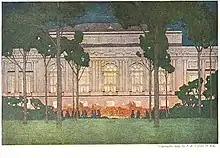
The New Theatre was once called "New York's most spectacularly unsuccessful theater" in the WPA Guide to New York City. Envisioned in 1906 by Heinrich Conried, a director of the Metropolitan Opera House, its construction was an attempt to establish a great theatre at New York free of commercialism, one that, broadly speaking, would resemble the Comédie Française of Paris. Thirty founders each subscribed $35,000 at the start, and a building designed to be the permanent home of a repertory company was constructed on Central Park West on the Upper West Side at a cost of three million dollars. Architecturally, it was one of the handsomest structures in the city, designed by the prominent Beaux-Arts architectural firm Carrère and Hastings.
With Winthrop Ames as the only director, the New Theatre Company occupied the building for only two seasons, 1909–10 and 1910–11. Capable of seating 2,300 persons, the New Theatre was opened on Saturday, November 6, 1909, with impressive ceremonies and apparently under the most favoring auspices, but a serious defect in the acoustics became apparent at once and this was only partly remedied by the installation of a sound-deflecting bell. The world premiere of Sergei Rachmaninoff's 3rd piano concerto took place on Sunday, November 28, 1909, at the New Theatre, with Rachmaninoff as soloist and Walter Damrosch conducting the New York Symphony Society. Several Shakespearean plays were given, by far the most notable presentation being that of The Winter's Tale. On the whole the company did its best ensemble work in some of the modern plays of that time, like Maeterlinck's The Blue Bird and Sister Beatrice, Galsworthy's Strife, and Edward Sheldon's The Nigger starring Annie Russell. A poetic drama of distinction was Josephine Preston Peabody's The Piper. In most cases the stage settings were of very high quality.
The building was located a mile above the Theater District, and it was exceedingly expensive to maintain. Financially, the venture proved to be a boondoggle.[4] At the end of the second season, the founders of the company decided to abandon the theatre and lease it out.[5] Plans were made to construct a smaller building in the theatre district,[6] but it was found to be impracticable and the company folded.[7] The theatre critic William Winter wrote:
Not long ago an institution which was expected to benefit the Stage and the Public went down in miserable failure, in the collapse of the New Theatre. The Directors of that institution provided 'practically unlimited capital' for the venture, — an aid which Lester Wallack, for one, never had and never dreamed of having. The observer of to-day was able to see at first hand exactly what kind of theatrical company could be formed after a long absence of stock-companies; half a million dollars was lost in the effort, and persons of experience, knowledge, and taste have had an opportunity to see what the much-vaunted 'commercialism' has really done for the American Stage, and how necessary it is that other forces should control it.[8]
Century Theatre
In 1911, the building was leased to other theatre managers, who changed the name to the Century Theatre, the Century Opera House (1913), and the Century once more (1915), with Florenz Ziegfeld as manager.
From Europe in 1912 came Judith Gautier and Pierre Loti, producers and supervisors of The Daughter of Heaven. Despite their efforts, the critic of The New York Times found the play "rich in spectacle, but dramatically deficient", and the scene changes tedious and "long delayed".[9]
In 1917, producers Florenz Ziegfeld and Charles Dillingham opened the roof garden[10][11] as a nightclub and named it the Cocoanut Grove, based on the success of a similar venue, Ziegfeld Midnight Frolic at the New Amsterdam Theatre.[12] The "Shrine of Snobbism", as the WPA Guide called it,[13] was demolished in 1930.[14] The next year, the Art Deco Century Apartments (designed and developed by the office of Irwin S. Chanin) was completed on the Century Theatre's site.[15][16][17]
Gallery
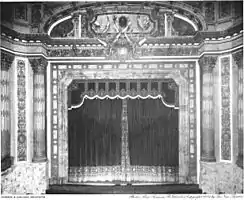 Proscenium and curtain
Proscenium and curtain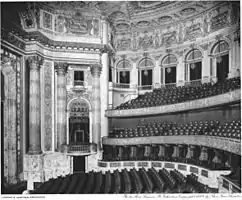 Auditorium
Auditorium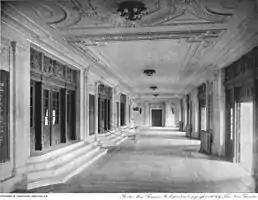 Main vestibule
Main vestibule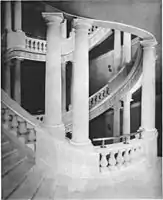 Staircases
Staircases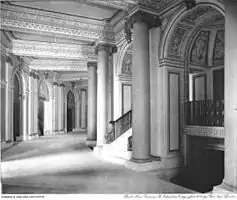 Foyer-level circulation
Foyer-level circulation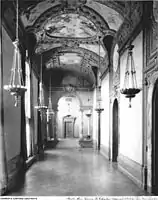 Main foyer
Main foyer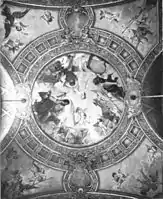 Foyer ceiling, central panel
Foyer ceiling, central panel Foyer ceiling, secondary panel
Foyer ceiling, secondary panel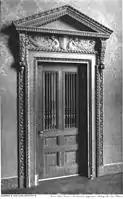 Foyer door
Foyer door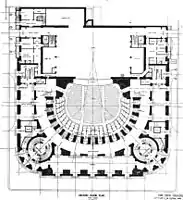 Ground floor plan
Ground floor plan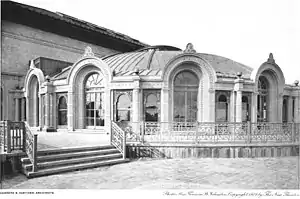 Rooftop Garden Pavilion
Rooftop Garden Pavilion Poster case
Poster case
References
- "Century Theatre Central Park West". Getty Images. Retrieved July 1, 2023.
- "The New Theatre, later called the Century Theatre, Central Park West and 62nd Street, New York City, Carrere & Hastings, architects, [1909?]". Digital Collections. New York Historical Society. Retrieved July 1, 2023.
- McNulty, William Charles. "Demolishing the Century Theatre, Central Park West and 63rd Street 1930". emuseum.nyhistory.org. Retrieved July 1, 2023.
Drypoint Plate: 8 5/8 x 11 1/8 in.; sheet: 13 3/4 x 17 1/4 in.
- "Chapter 22". Among the Daughters.
- "Founders Abandon the New Theatre", The New York Times, March 10, 1911.
- "The New Theatre's New Site", The New York Times, March 18, 1911.
- "The New Theatre", The New York Times, December 22, 1911.
- William Winter, The Wallet of Time. Moffat, Yard and Company, New York 1913, vol. 1, p. 36.
- "Loti-Gautier Play at Century Theatre", The New York Times, October 13, 1912.
- "Century Theatre - New York City". nycago.org. Retrieved July 1, 2023.
- "SOCIETY GIRLS AID HOME.; Pose in Tableaux and Raise $1,500 for Homeless Boys' Charity". The New York Times. February 20, 1921. Retrieved July 1, 2023.
- "THE CENTURY ROOF OPENS ITS DOORS; The Cocoanut Grove Is a Good Looking Copy of the Ziegfeld Frolic. A COSTLY MIDNIGHT REVUE Lavish Entertainment for the Benefit of the Few Whose Seats Afford a View of the Floor". The New York Times. January 20, 1917. Retrieved July 1, 2023.
- Federal Writers' Project (1939). New York City Guide. New York: Random House. ISBN 978-1-60354-055-1. (Reprinted by Scholarly Press, 1976; often referred to as WPA Guide to New York City.)
- "$6,500,000 Loan on Century Site; Wreckers Begin Razing Theatre on Central Park West for Thirty-Story Apartment". The New York Times. October 24, 1930. ISSN 0362-4331. Retrieved November 12, 2019.
- "Apartment Renting on the West Side; Nineteen New Houses Opening This Season With Excellent Tenant Occupancy". The New York Times. September 13, 1931. ISSN 0362-4331. Retrieved November 12, 2019.
- "Fifteen Lease Central Park West Suites: Will Get Possession of New Homes in the Majestic and Century This Fall". New York Herald Tribune. September 24, 1931. p. 36. ProQuest 1114219619.
- "THE CENTURY APARTMENTS". New York Architecture Images. Retrieved July 1, 2023.
Sources
- Federal Writers' Project (1939). New York City Guide. New York: Random House. ISBN 978-1-60354-055-1. (Reprinted by Scholarly Press, 1976; often referred to as WPA Guide to New York City.)
- "Century Theatre" "New York"
 This article incorporates text from a publication now in the public domain: Gilman, D. C.; Peck, H. T.; Colby, F. M., eds. (1905). "Unknown". New International Encyclopedia (1st ed.). New York: Dodd, Mead.
This article incorporates text from a publication now in the public domain: Gilman, D. C.; Peck, H. T.; Colby, F. M., eds. (1905). "Unknown". New International Encyclopedia (1st ed.). New York: Dodd, Mead.- https://en.wikisource.org/wiki/Joseph_and_His_Brethren:_A_Pageant_Play/Note
- New Theatre (1909). The New Theatre, New York. New York, New York: De Vinne Press.
- names of founders, officers, etc., with biographical sketches and portraits of the company
- The New Theatre, Season 1909–10 (New York, 1910)
- titles of plays, dates of production, casts, etc.
External links
- Century Theatre at the Internet Broadway Database
- https://playbill.com/venue/century-theatre-1911-new-york-ny
- New Theatre costume designs, 1909-1911, held by the Billy Rose Theatre Division, New York Public Library for the Performing Arts
- Danni Bayles-Yeager Century ("New") Theatre Performing Arts Archive